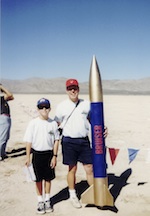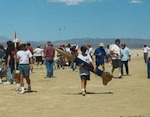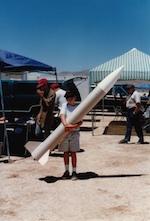Bruiser

| Diameter: | 7.67" | Type: | Sport |
| Length: | 71" | Status: | Active - 8 flights |
| Motor Mount: | 54mm | Build Dates: | 1997-06-14 to 1997-07-01 |
The Bruiser was the first high power rocket that I built with my dad. (Always start small, right?) We flew it many times on 38/600 motors (I435T and I284W) until it came in ballistic after one flight when the paper cap holding the ejection charge in fell off. We have since rebuilt it, adding an altimeter bay and rail buttons. It's somewhat awkward to transport, and thus doesn't get flown very often, but when it does, it's all about the drama - flights between 1000 and 2500 feet, and slow descents are the trademark of this LOC classic.
Flights
Since it was clear and calm and the sun was beginning to go down, I decided to pull out the Bruiser for a dramatic flight. The recovery system was prepped with an R14 to give a slow descent, and a J275 was prepared with a short delay. I flew it from a rod on an old LTR-style pad, for added effect. Liftoff was slow and stately, and the boost was nice and straight. Deployment was slightly early, causing a small zipper, but the bird descended nicely on the R14 and made a gentle touchdown just behind the flight line.
With the day going well and the breeze staying down, I decided to go for it with the punchy J460T in the Bruiser. To keep the rocket from shifting on the pad prior to flight, my dad had built a PVC stand for the rocket to sit on, which worked well. The big rocket lumbered off the pad on the bright blue flame, and headed skyward for a successful flight.
This was the first flight of the Bruiser on its "full load" of a J275W after it met with disaster at the Bonneville Salt Flats, when a hard landing popped a fin off. The paper flight log puts my twelve year-old reaction best: "!!WOW!" Though the big new RocketRage Raspberry 84" chute got a little tangled, it still opened almost completely, landing the rocket safely on the range.
After flying the Expediter to 2300 feet to knock the edge off the nerves, it was time for the main event: fly the rebuilt Bruiser for the first time since its awful lawn dart the previous September. This time, we made extra certain to tape the forward closure black powder well to insure the deployment charge would stay in place. And it worked like a charm - the freshly painted bird rose dramatically about 1200' into the air and ejected its big parachute at apogee. Jeff Stai captured this great launch photo, too. Success!
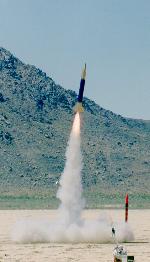
others: preflight, in line | pad prep with dad
Boost was good on the snappy AT full I motor. However, things soured quickly at apogee, when the parachute failed to eject and the Bruiser piled into the lakebed. I remember Larry "Bubba" Jacobs explaining it to me: "It's all part of the hobby, don't worry... you can pick up the pieces and fly it again!" (And anybody who knew Larry Jacobs knew he was in the perfect position to hand out that kind of advice! :)) The failure was traced to the sticky dot on the forward end of the motor responsible for holding the black powder in; it had become contaminated with grease and fell off in handling, allowing the powder to spill out, and thus no ejection.
The Bruiser (now in primer) was our last flight of the day. We had prepped it in the morning, but the gusty winds made me second-guess the decision to fly it. Finally, as the day was closing, I decided to just go for it. She lifted off the pad nice and straight, but quickly cocked over and headed to the east. Ejection was extremely late, causing the plastic eyelet on the nose cone to pop apart and the cone to free-fall to the playa, unharmed. The body section recovered on the 78" chute as normal. Turns out, in the haste of final motor prep, we had used the supplied -M delay instead of the required -S.
Well, now that we knew it flew well on the punchier blue motor, we wanted to try again, this time on the white load for more drama. Reloading was quick (again with the wadding) and after RSOing from Buck Gomez, it was back out to pad 23 for another flight. I kinked the head of the HiRel e-match to make sure it contacted the grain of the harder-to-light white propellant, which did the trick. The Bruiser made a nice, gentle, arcing flight to the east, deploying its chute again at apogee. Scott and I chased the rocket down on the range for an easy recovery.
After prep at our camp, adding what seemed like an ungodly amount of dog barf wadding, we headed up to motor dealer Ken Finwall's California High Power Model Rockets tent to pick up the reload case and have him help us with final checks on the rocket. Though we had neglected to drill pressure vent holes, the general consensus was that, since it would only be reaching 1000 feet or so, it wouldn't be a problem. We got it loaded on the rod with little trouble (+1 for light paper construction techniques) and the LCO called out the count. The I435 punted the big airframe into the sky, burning out in just over a second. The rocket coasted silently to apogee, and as I held my breath, the big black chute unfurled and the Bruiser descended for a perfect landing just behind the flight line.
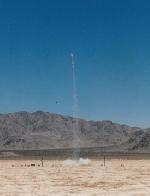
others: checking with ken | recovery with scott
